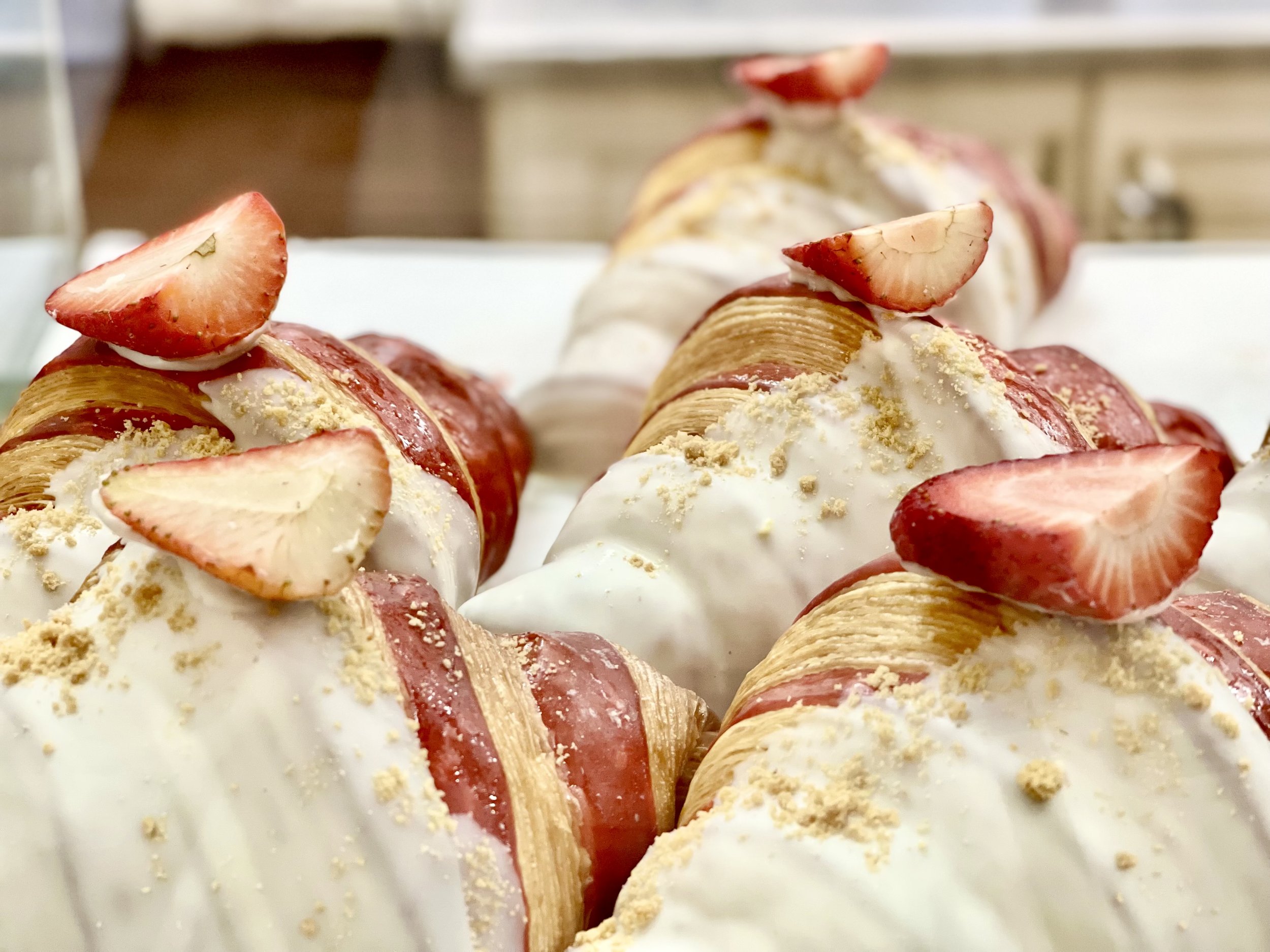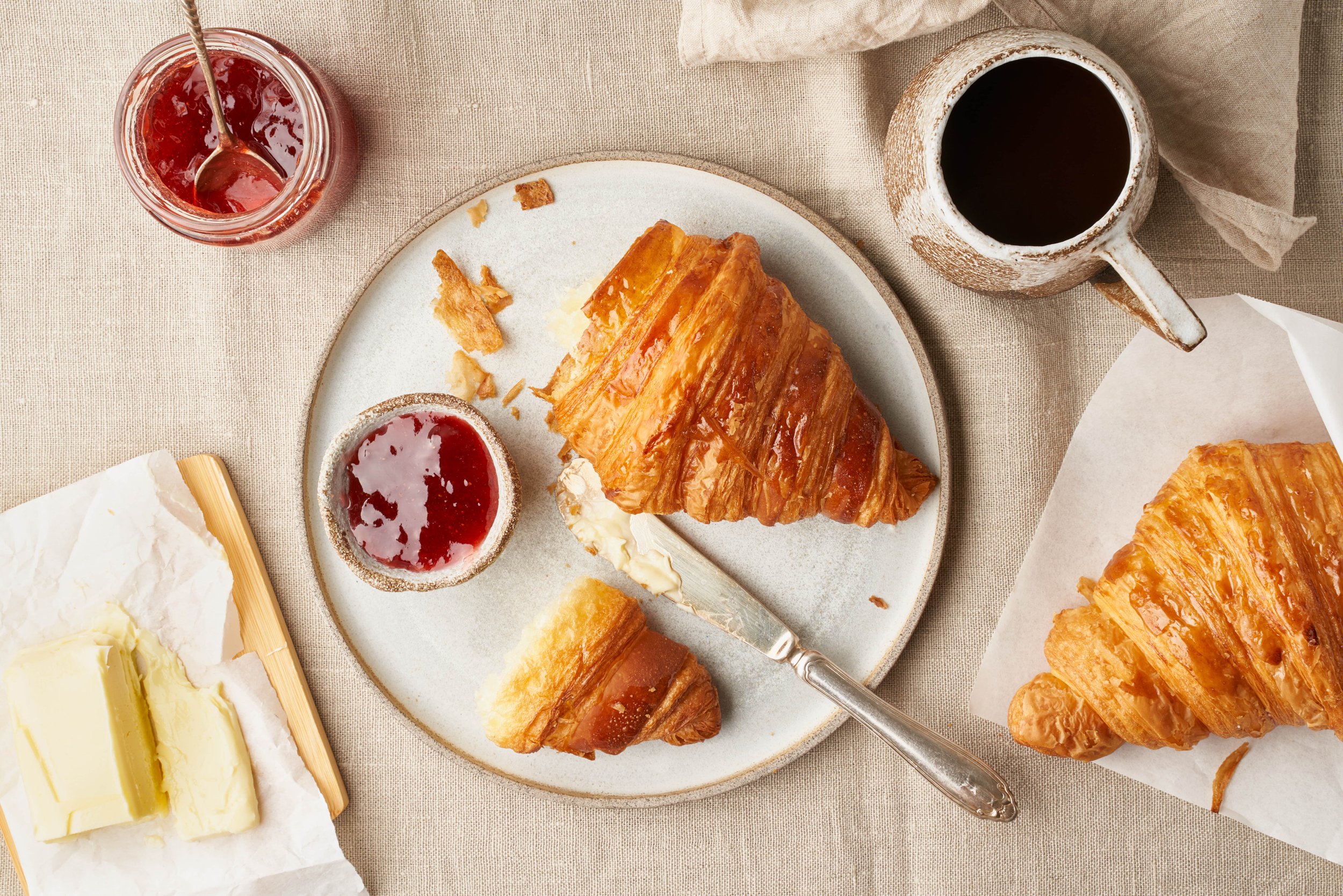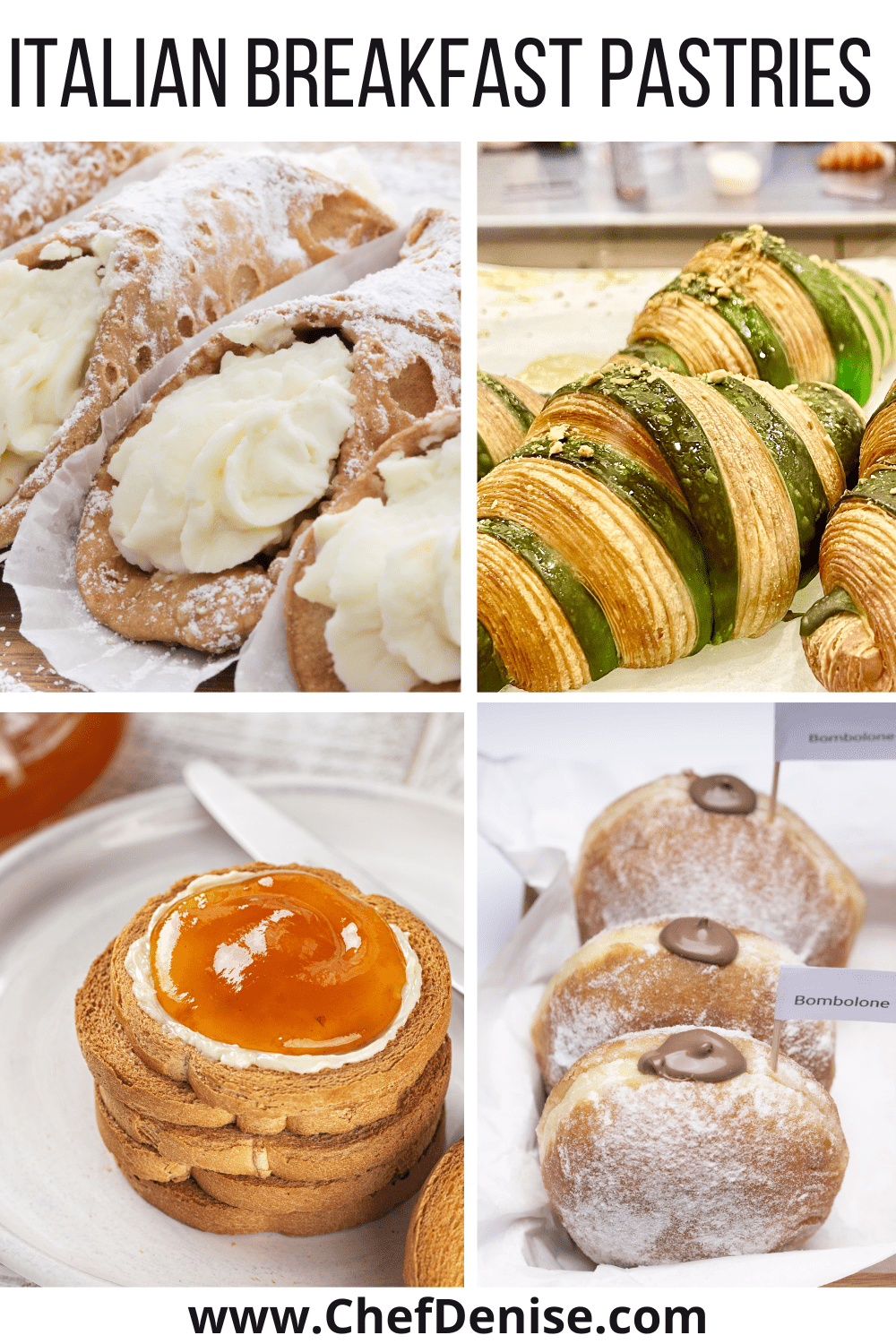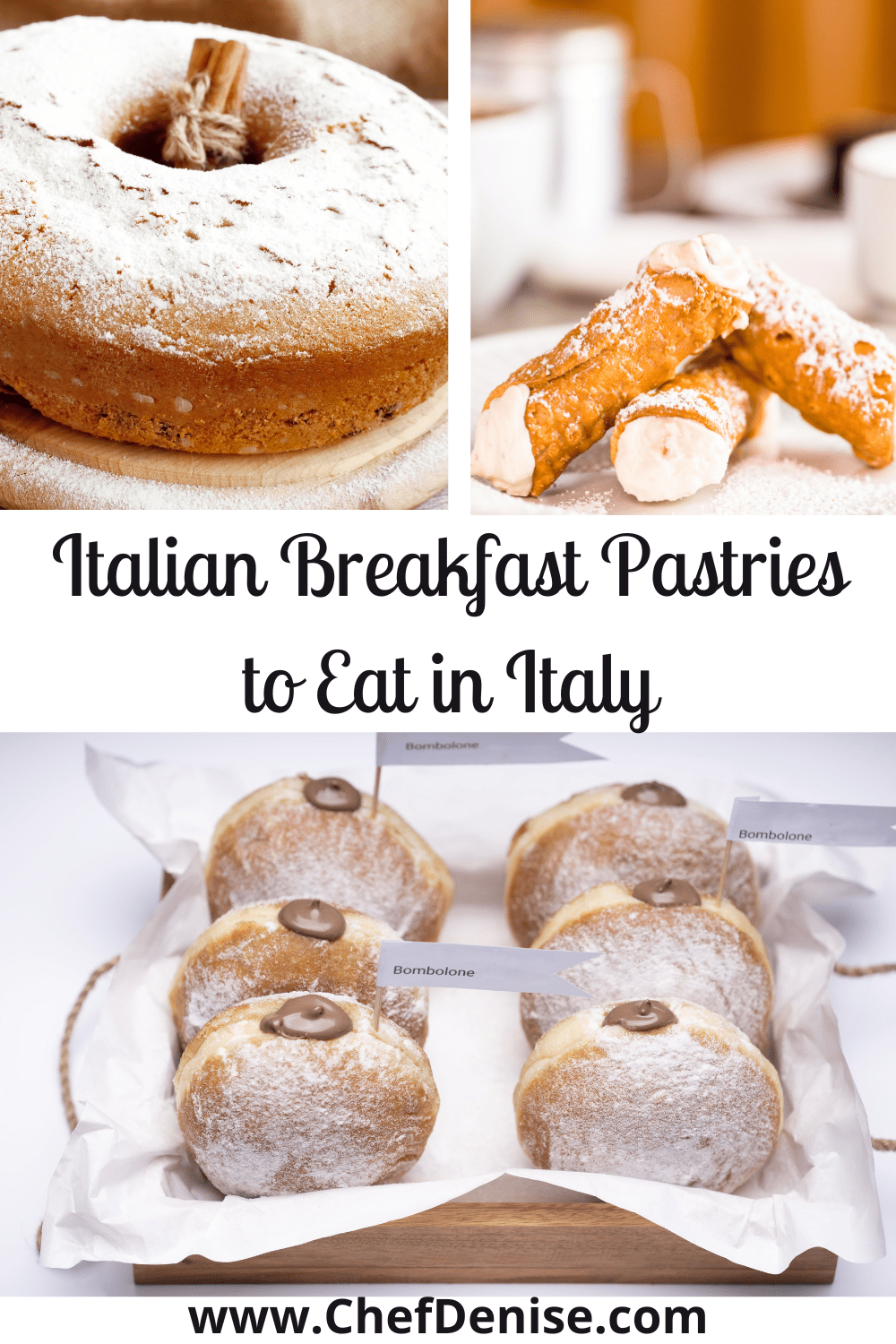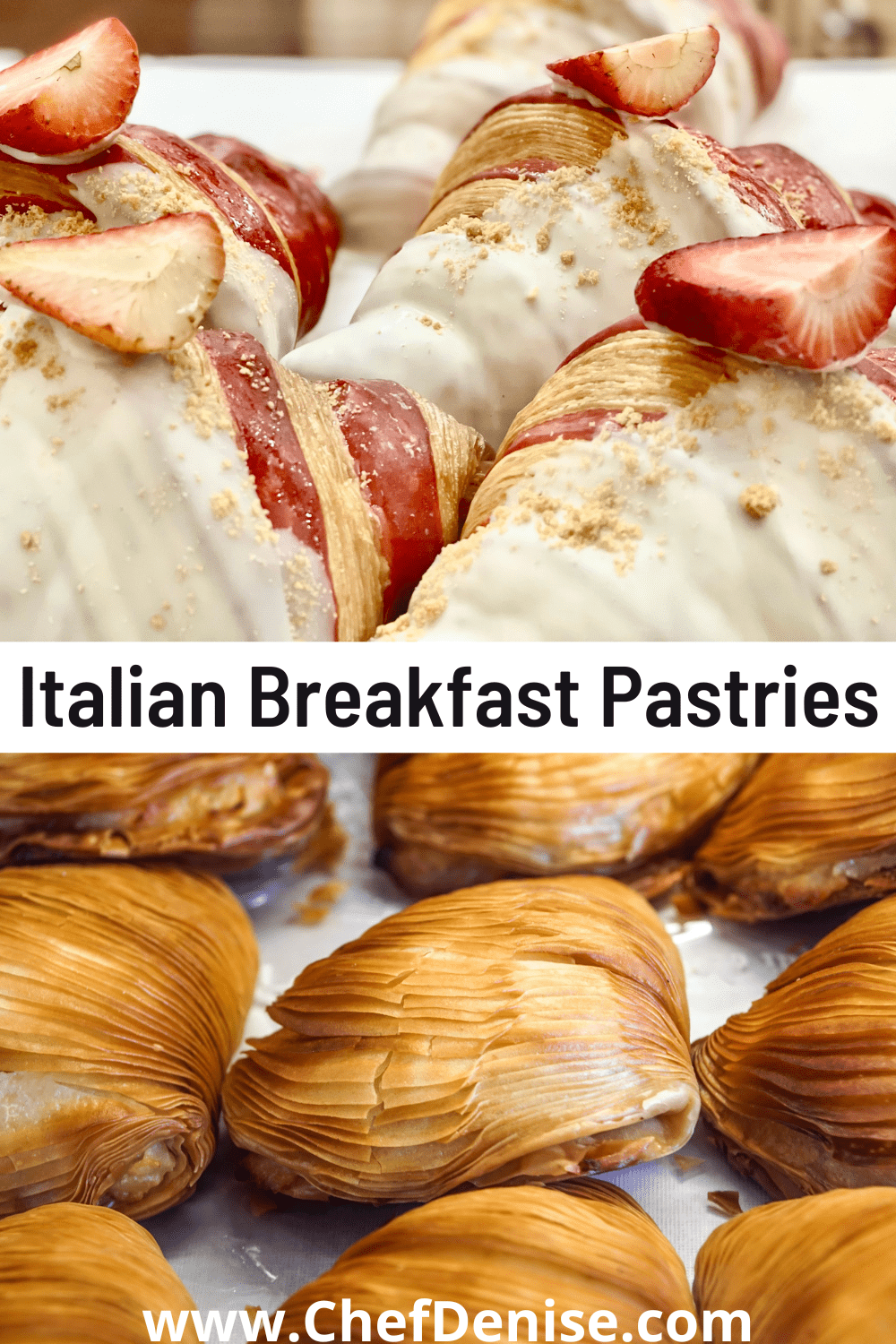9 Popular Italian Breakfast Pastries To Try in Italy
Perhaps it’s because Italian food is so amazing, and Italians know that delicious options await them at lunch and dinner. Maybe it’s because Italian households are just as hurried as we are to get out the door to school and work in the mornings. Or maybe the idea of breakfast as the most important meal of the day just hasn’t caught on in Italy.
Whatever the reason, the average Italian breakfast table does not delight with a filling breakfast that looks as gorgeous as it is substantial.
Although at home some Italians eat breakfast cereals or yogurt with fresh fruit like many of us here in the U.S. do, breakfasts in Italy are almost never an elaborate affair.
According to a recent poll, the typical Italian dedicates very little time or thought to the first meal of the day, with the average Italian colazione (breakfast) usually eaten in less than 13 minutes.
Indeed, the typical breakfast in Italy is simply a cup of coffee and a breakfast pastry or even just a slice of some type of bread with burro e marmellata, that is, butter and jam. There is certainly not going to be a hearty savory breakfast with bacon or sausage. No, the classic Italian breakfast veers toward sweet food, very little of it, and a morning coffee.
The good news is that Italian culture is a coffee culture, and even though popular Italian breakfasts at home can be a meager affair, Italians love to enjoy their morning shot of espresso or cup of cappuccino at their favorite local bar or at one of the attractive coffee shops that dot most towns and cities. And, that’s where different types of delicious breakfast pastries are also on offer. So, that’s where we’re heading too!
Italian Breakfast Pastries
When in Italy, to enjoy the first meal of the day in the most common way, we make our way to an Italian bar. To the uninitiated, this might seem a little hard core, or even cringe, but in Italy, it’s a great way to start the day. That’s because Italian bars differ quite a bit from their American counterparts.
Although they might serve alcohol later in the afternoon, Italian bars open early and start offering a fine array of coffee choices first thing in the morning. And the best way to enjoy a morning brew is to pair it with a popular Italian pastry. But which to choose?
Biscotti
If you’re like the majority of Italians, you choose the almost ubiquitous type of Italian pastry, the biscotto (the singular “biscotto” ends in “o,” the plural ends in “i”). They are by far the most common breakfast in Italy. But unlike most typical Italian breakfast foods, these Italian breakfast items are not sweet treats. Instead, they are twice-baked biscuits that pack a crunch.
Whether plain biscuits or the almond-filled “cantucci” that are a beloved Tuscan traditional food, biscotti come in oblong shapes that resemble miniature slices of hard bread. At breakfast time, they’re dunked into coffee to soak up the delicious flavor and soften up the biscuit’s tough texture.
Biscotti are also one the most popular breakfast foods in Italy among children, who dunk these breakfast cookies in their morning milk. Although still made daily by pastry chefs and delivered to bars and coffee shops fresh, biscotti are so popular that today there are even mass-produced varieties of Italian breakfast biscuits that line grocery shelves, with Mulino Bianco the leading brand.
Cornetti
Cornetti are the Italian cousins of the popular French breakfast pastries known as croissants. And like the French croissant, the Italian version shares the same predecessor, the Austrian Kipferl.
But the French and Italian pastries have significant differences. Although both are made from rolled dough repeatedly buttered, folded, and shaped, cornetti are larger, sweeter, less flaky, and more often stuffed with flavorful fillings than are croissants.
An unstuffed cornetto is referred to as “vuoto,” or empty, whereas a stuffed one is “ripieno,” or filled. Stuffed cornetti usually have a little blob of filling sticking out of their top to assist you in picking the flavor you’d like. Popular fillings are marmellata (marmalade), crema (custard), cioccollato (chocolate, often Nutella), and pistachio paste.
Although the cornetto can be thought of as an Italian croissant or croissant-shaped pastry, the name “cornetto” means “little horn,” because that’s what the Italians think these pastries most resemble.
Cornetti are among the most popular breakfast foods throughout Italy. However, different regions of the country call this tasty type of pastry by different names. In central and southern Italy, “cornetto” rules, whereas in northern Italy, the term “brioche” predominates.
And no matter how popular the cornetti is in Italy, worldwide, the French famous food surpasses it by miles.
Fette Biscottate
This is one of the traditional Italian breakfast foods that I have to admit I just don’t get. Translated as “twice-baked slices,” that’s exactly what these are: Slices of bread that are cooked twice until they are incredibly dry and brittle—and almost flavorless.
They can show up at your hotel’s continental breakfast, at your colazione al bar (“breakfast at the bar”), or at a slap-dash morning meal at an Italian friend’s house. Make it stop! Just kidding (sort of); for some reason, many Italians love them.
Fette Biscottate are slathered with jam, butter, Nutella, or other toppings to impart flavor. They are dunked in coffee so as not to break a tooth when biting into them. But with so many better options out there, I keep my distance. In fact, these are one of the Italy breakfast foods it’s hard not to forego for a better choice. But, love them or hate them, just know that they are out there.
Bomboloni
Now these are the kind of pastries everyone can get behind! Well, at least anyone who is not afraid that a few of these are going to ruin sculpted abs or balloon their own behind.
They are feather-light sweet breakfast doughnuts that are fried, stuffed with a delicious filling, and topped with icing sugar.
Although their name probably originally comes from their resemblance to grenades or old-fashioned bowling-ball-shaped bombs, the term is still perfectly fitting, since biting into one of these beauties sets off an explosion of flavors in your mouth. Popular fillings include custard cream, whipped cream, jam, and chocolate.
If bomboloni are not available at a local bar close to where you are staying, seek them out a pasticcheria (pastry shop) or forno (bakery). They are easy Italian breakfast pastries to fall in love with and something you should not leave Italy without trying.
Sfogliatelle
I can’t even begin to pretend I’m impartial about this particular Italian breakfast pastry. My nonna’s family came from Campania, where the sfogliatella originated, and it is without a doubt our family favorite. So, of course, it’s on must list of must-eat foods of Campania too.
Using a rolling pin (old school) or pasta machine (genius), a mamma, nonna, pastry chef, or masochistic amateur overachiever painstakingly produces long, thin sheets of dough. The pieces of dough are then folded, stacked, shaped, and filled with a heavenly concoction. Once each puff pastry is sealed, the surface of each is brushed with butter and baked. They emerge from the oven looking like elaborately layered seashells.
These layers are in fact how this pastry got its name. The term “sfogliatella” (ending in “a” for singular, “e” for plural) comes from the word for “leaf,” because each of the delicate layers is as thin as a leaf.
In Italy, the popularity of sfogliatelle has now spread far beyond Campania, so fillings vary considerably. Ricotta is still overwhelmingly used, and is often flavored with orange peel or lemon zest. However, other fillings include everything from almond paste to black cherries.
No matter where you find some or what they are filled with, try these transcendent traditional Italian breakfast pastries. The buttery, flaky layers lovingly nestle whatever filling their creator has chosen, and the warm combination is oh so satisfying to bite into and enjoy until, alas, there is no more.
Maritozzi
The origins of maritozzi date back over a thousand years to medieval Rome, and it is in Rome where these pastries are still mostly widely found in the Italy of today. Most often they are considered breakfast, but they can also be a snack or decadent Roman street food.
In the Middle Ages, young men would offer these cream buns to their sweethearts as a sort of valentine during Lent.
Some maritozzi even had an engagement ring hidden within their incredibly creamy center. It’s no accident then, that the name of this pastry, a spin on the term for “husband,” can be roughly translated as “hubby.”
According to their traditional recipe, these pastries are a ball of soft, sweet dough made with flour, olive oil, sugar, pine nuts, raisins, and candied orange peel. Once the dough is baked, a swathe is cut from the top of the ball almost down to the base and then filled with a decadent dose of whipped cream.
The resulting white stripe on the top of the maritozzi is like a beacon advertising the delicious filling within. If you see such a beacon, it would be a genuine shame to pass it by this Roman food without giving it a try.
Cannoli
You may know this decadent pastry as the quintessential Sicilian dessert. After all, these tubes of fried pasta dough stuffed with a sweet, creamy, ricotta-based filling are no longer a rarity in the States. Luckily we can find them in locales with vibrant Little Italy neighborhoods, like Boston’s North End, San Francisco’s North Beach, and in the largest Little Italy in American, San Diego.
But in Sicily, and increasingly elsewhere in Italy, cannoli are also a perfectly legit breakfast option. And the snap and crackle as you bite into the crunchy shell to get to its creamy center is a good reminder that no one in this world has a monopoly on noisy breakfast foods.
What may be surprising is that when Sicily sizzles under Italy’s southern sun, the locals sometimes pair their breakfast cannoli with a granita, or Italian shaved ice, to cool off. And because the Sicilians are known for their sweet tooth, it makes perfect sense that they would top their granita with a dollop of whipped cream when they’re in the mood. After all, life is short—and whipped cream is delicious.
Pasticiotti
This Italian breakfast pastry hails from Puglia, the heel of Italy’s boot. Created in the 1700s in the city of Lecce, Puglia’s baroque treasure, pasticiotto has been a beloved breakfast food in the region ever since.
The creation is a short-crust pastry traditionally filled with a vanilla or lemon-zest-inflected custard. The egg-white-washed top turns golden brown while baking, and the not-too-flaky, not-too-breaky exterior teams up perfectly with the tasty, gooey center to produce an ideal hand-held comfort food.
Having gained popularity beyond Puglia, pasticiotti have not only broadened their appeal but also the variety of fillings used in their preparation. Traditional or not, a still-warm pasticiotto is a unique pleasure not to be passed up—especially in Puglia, where these pastries are as much of a beloved staple as the famous Pugliese orecchiette.
Ciambellone
Although perhaps not a pastry, this sponge cake is a quintessential breakfast food originating in Italy’s always-food-focused Emilia-Romagna, so it really shouldn’t be overlooked.
Recipes vary widely, but the soft, fluffy texture and bundt-cake ring shape are hallmarks of this sweet breakfast treat. Today, flavorings cover the gamut, from traditional citrus and vanilla to chocolate.
Ciambellone is an excellent example of the branch of baked-good breakfasts known as crostate e torta—pies and cakes that, whether or not originally designed for the first meal of the day, end up being a big hit at breakfast time.
Don’t be surprised if you find this offering along with all the wonderful pastry choices wherever you have your next Italian breakfast.
What to drink with Italian Breakfast Pastries
As with a typical French Breakfast, a traditional breakfast in Italy usually includes a hot beverage. Most often that means coffee of some kind.
The most popular coffee drinks at Italian breakfast meals are espresso, cappuccino, and caffe latte. A fun fact about ordering espresso—it is served with a glass of water so you can cleanse your pallet before introducing your taste buds to the robust flavors of this delectable brew.
If you travel to Italy and are not a coffee drinker, do not fret. Fruit juices, tea, and hot chocolate will also be available on your Italy breakfast menus.
Hot chocolate is especially prevalent in northern Italy where the city of Torino is famous for the chocolaty specialty.
No matter when you get to Italy, or where you visit, I hope this article helps you choose the best breakfast food in Italy, and I hope your mornings include at least some of the best Italian breakfast pastries, accompanied by phenomenal breakfast bevvies.
Buon appetito!

